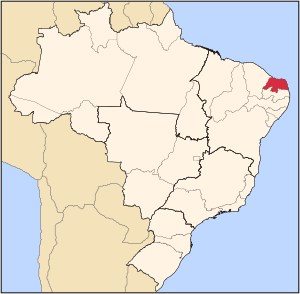Rio Grande do Norte facts for kids
Quick facts for kids
State of Rio Grande do Norte
|
|||
|---|---|---|---|
|
|||

Location of State of Rio Grande do Norte in Brazil
|
|||
| Country | |||
| Capital and Largest City | Natal | ||
| Area | |||
| • Total | 52,796.791 km2 (20,384.955 sq mi) | ||
| Area rank | 22nd | ||
| Population
(2012)
|
|||
| • Total | 3,228,198 | ||
| • Rank | 16th | ||
| • Density | 61.143830/km2 (158.361792/sq mi) | ||
| • Density rank | 10th | ||
| Demonym(s) | Potiguar or Norte-rio-grandense | ||
| GDP | |||
| • Year | 2006 estimate | ||
| • Total | R$ 20,557,000,000 (18th) | ||
| • Per capita | R$ 6,754 (20th) | ||
| HDI | |||
| • Year | 2005 | ||
| • Category | 0.738 – medium (21st) | ||
| Time zone | UTC-3 (BRT) | ||
| • Summer (DST) | UTC-2 (BRST) | ||
| Postal Code |
59000-000 to 59990-000
|
||
| ISO 3166 code | BR-RN | ||
| Website | rn.gov.br | ||
Rio Grande do Norte is one of the 26 states of Brazil. It is in the northeastern part of the country. It is on the edge of the South American continent.
Geography
Rio Grande do Norte has a large coastline. The state is well known for its beaches and sand dunes. The air is the cleanest in South America.
Because of a large mountain chain called Serra da Borborema, Rio Grande do Norte has two main climates. The area along most of the coastline is very tropical. Inland, much of the state is very dry.
The dry climate is not only because by the low amount of rainfall but also because of the fact that it rarely rains at all. Often years go by with no or very little rain. Most of the interior of the state is part of the Polygon of Droughts. This is an area which gets special attention from the federal government.
Rocas Atoll belongs to the state of Rio Grande do Norte. It is in the Atlantic Ocean, 260 km Northeast of Natal.
History
The first European to come to the region may have been the Spaniard Alonso de Ojeda in 1499. The northeastern tip of South America, cape São Roque, was first seen by European navigators in 1501. This was during a 1501-1502 Portuguese expedition led by Amerigo Vespucci. He named the spot after the saint of the day. The Vespucci expedition also named the Potengi river, "Rio Grande". The name is Portuguese for "Great River". The area and state were named after the river. For decades, no permanent European settlement was made in the area.
In the 16th century (between 1535 and 1598), the area was explored by French pirates. In 1598, the Portuguese built the Forte dos Reis Magos. The next year, they created the city of Natal.
In 1633, the area was fought over between the Portuguese and the Dutch. In 1654, the Dutch were finally cast out.
During World War II, Rio Grande do Norte was used as an Allied airbase. The base was used to attack German-occupied North Africa.
In 1964, Latin America's first space launch site was built in Rio Grande do Norte; Barreira do Inferno (Hell's Barrier). It is often called the "Brazilian NASA".
Economy
Historically, the economy of Rio Grande do Norte has been based on sugar and cattle. In the 1980s, the state government has realised that tourism is a very good industry. Since then, more money is being used to build placed for tourists and repairing colonial buildings in major cities.
Fruit is also grown in Rio Grande do Norte. The state grows 70% of Brazil's melons. The state is famous for its mango and cashew fields. The world's largest cashew tree is there. It has a circumference of 500 metres and an area of 7,300m². It is 70 times the size of average cashew trees.
Cities
Natal is the capital and largest city in the state. Other cities include:
- Açu
- Angicos
- Apodi
- Ceará-Mirim
- Currais Novos
- Parnamirim
- Japi
- Mossoró
- Caicó
- São Fernando
Flag
The flag was adopted on December 3 1957. It is based on a design by Luis de Camara Cascudo. In the middle of the flag is the coat of arms of the state. The coat of arms was adopted on July 1 1909. It shows a sailing boat at the coast in the middle. This is for the fishing and salt industries. Above this is a bar which shows two flowers on the sides and two cotton bolls in the center. To the sides of the shield are a coconut palm to the right and a carnauba palm to the left. The two palms are connected by two branches of sugar cane. The star above represents the state as part of Brazil.
| States of Brazil | |
|---|---|
| Acre | Alagoas | Amapá | Amazonas | Bahia | Ceará | Espírito Santo | Goiás | Maranhão | Mato Grosso | Mato Grosso do Sul | Minas Gerais | Pará | Paraíba | Paraná | Pernambuco | Piauí | Rio de Janeiro | Rio Grande do Norte | Rio Grande do Sul | Rondônia | Roraima | Santa Catarina | São Paulo | Sergipe | Tocantins | |
| Federal District: Brazilian Federal District | |
Images for kids
See also
 In Spanish: Río Grande del Norte para niños
In Spanish: Río Grande del Norte para niños











